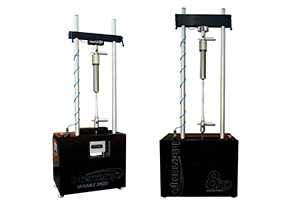Application Note: Decoding Shock Science
Category: Racing
May 24, 2019
Shock absorbers are vitally important when tuning the performance of any racecar. While that is universally accepted, opinions differ on how to achieve the optimal setup. A shock dynamometer is one piece of equipment that can be used to analyze and improve the performance capabilities of shock absorbers.Intercomp’s easy-to-use line of shock dynos gives race teams and shock specialists the ability to extract the data needed for various vehicles in multiple operating conditions.
Intercomp’s competitively-priced shock dynos come in three models: a Variable Speed 3hp, High Speed 3hp, and Variable Speed 8hp. The 3hp models are ideal for most racing applications. The 8hp machine adds the ability to test high-force shocks, like those found in powersport, off-road, motorcycle, cycling and testing for high-volume OEM applications.
Each Intercomp Shock Dyno is built in the US with high-quality, industrial-strength components and a Compression/Tension load cell specifically designed to measure compression and rebound forces. Other shock dynos are designed with an s-type load cell that can measure both forces, but is only designed to precisely measure tension forces, leaving the door open for inaccurate compression data. All models are able to test various stroke lengths with a simple adjustment, and a moveable top mount allows testing of most shock, strut and damper configurations.
In addition, each model includes a dedicated laptop computer with Intercomp’s Shock Dyno Software preloaded. The easy-to-use software provides continuous control over dyno speed and measurement. The Live Data mode allows users to see a Force vs. Absolute Velocity graph created as the shock is extended and compressed. This provides a ‘snapshot’ of shock performance to ensure proper assembly after a rebuild. Full test profiles allow the user to analyze and save data, including Force vs. Absolute Velocity, Force vs. Displacement, Seal Drag and Shock Rod Pressures. Shock test graphs can overlay old and new data to compare performance of a single shock over time.
Aside from tracking performance changes, an Intercomp Shock Dyno provides the race engineer, shock specialist or crew chief the data to make specific shock changes to better control the handling characteristics of a vehicle. Likewise, it gives sportsman racers the ability to report specific numbers to a chassis builder, or other specialist, increasing the chance of obtaining helpful input.
Attachments:



